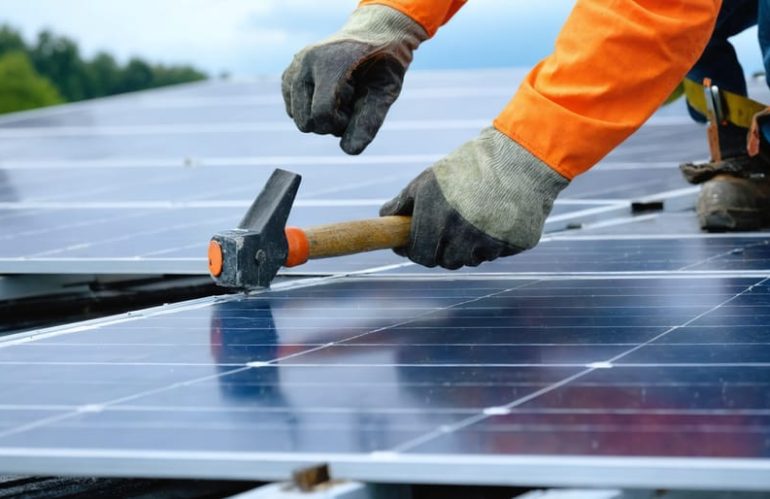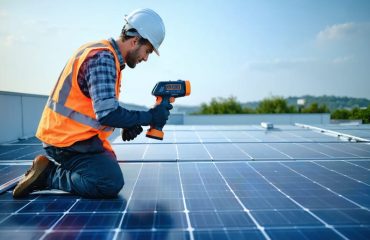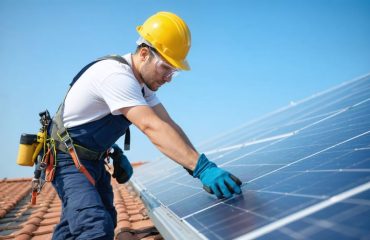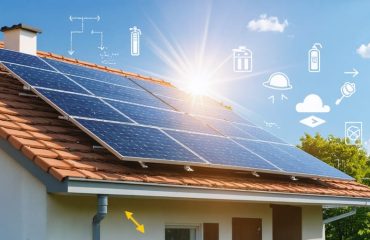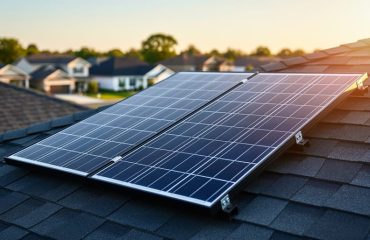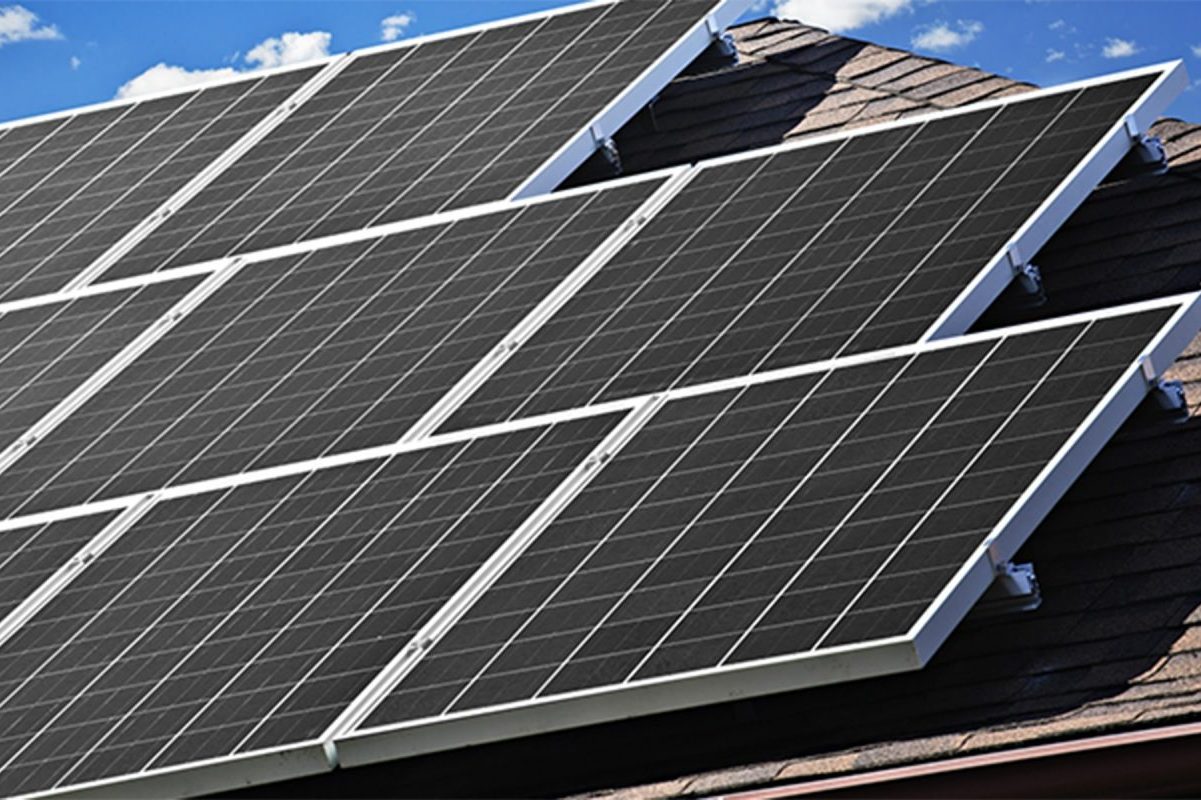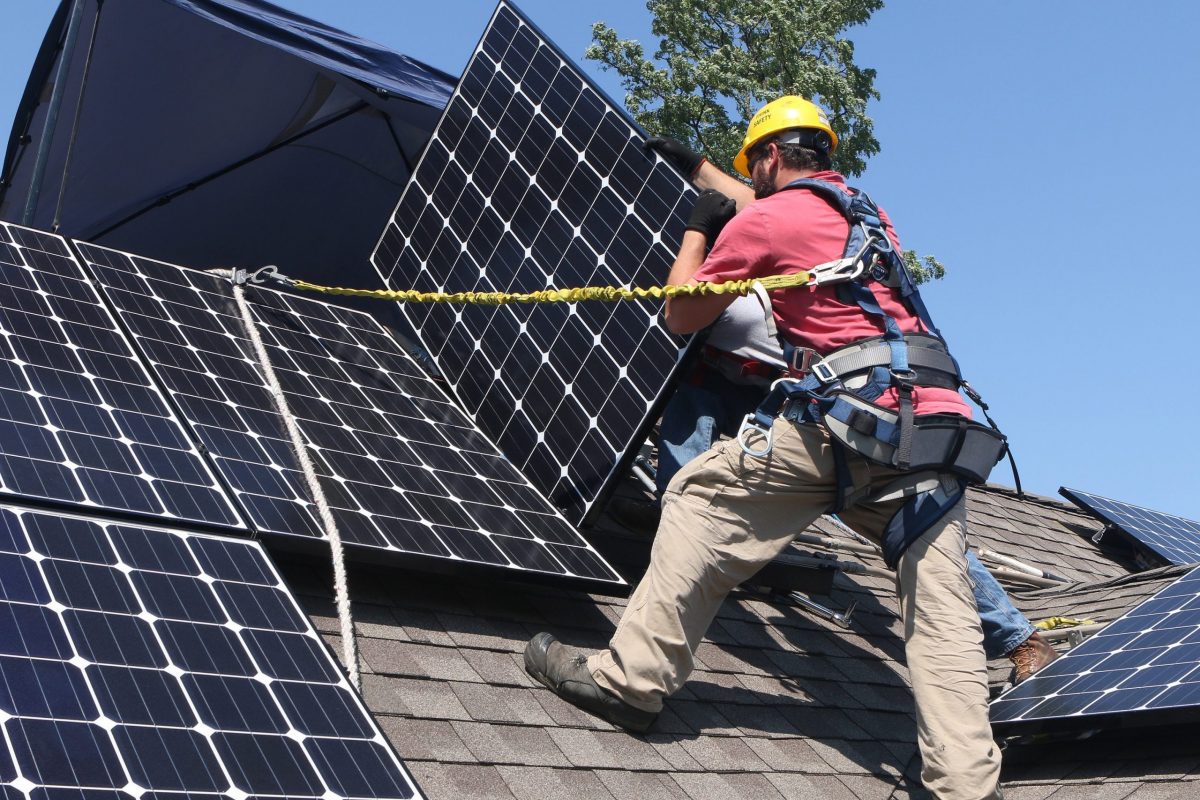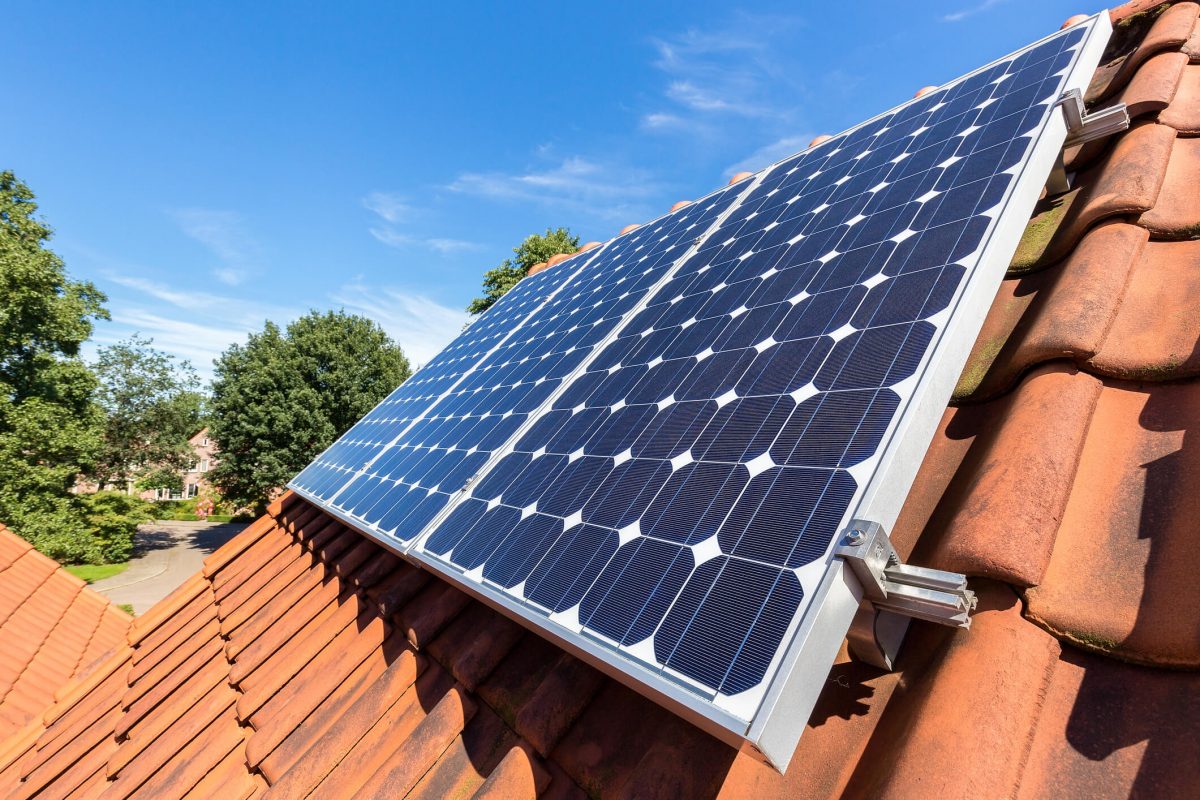When you see a solar installer rhythmically tapping panels with a heavy rubber mallet, they’re not being rough with your expensive equipment—they’re performing a crucial precision task. That purposeful striking securely seats the panels into their racking system, creating the tight, weatherproof fit that protects your investment for decades to come.
The rubber mallet is the tool of choice precisely because it delivers force without damage. Unlike metal hammers that could crack fragile solar cells or dent aluminum frames, the soft rubber absorbs shock while still providing enough impact to lock mounting clips into place and align panel edges perfectly. This careful balance between power and protection separates professional installers from amateurs.
Understanding what happens on your roof demystifies the installation process and helps you recognize quality workmanship. Those deliberate mallet strikes you hear aren’t random—they’re part of a systematic approach that ensures every connection point meets manufacturer specifications. When installers use the right tools correctly, they’re building a system engineered to withstand wind, rain, and snow while generating clean energy that slashes your electricity bills for 25+ years.
The Heavy Rubber Mallet: An Installer’s Essential Tool
When you see a solar panel installer tapping away with what looks like an oversized hammer, there’s careful precision behind every swing. The heavy rubber mallet is one of the most essential tools in a professional installer’s kit, and it plays a surprisingly important role in ensuring your solar system performs flawlessly for decades to come.
The rubber mallet’s primary job is to secure mounting hardware firmly into place. Unlike metal hammers that can dent, crack, or damage sensitive equipment, the rubber head delivers controlled force that seats components snugly without causing harm. Installers use it to tap mounting rails into their brackets, ensuring everything sits flush and stable. This matters because even small gaps or misalignments can lead to rattling, water infiltration, or structural issues down the line.
During panel positioning, the mallet becomes an extension of the installer’s hands. Solar panels need to fit together precisely within their mounting framework, with minimal gaps between units. A gentle tap here and there helps nudge panels into perfect alignment, creating that clean, professional look you see on finished installations. This careful adjustment also ensures proper electrical connections and weatherproofing between components.
The tool is particularly valuable when securing clamps and fasteners that hold panels to the racking system. These connections must be tight enough to withstand decades of wind, rain, and temperature changes, yet the components themselves are relatively delicate. The rubber mallet provides just the right amount of persuasion without risking cracks in the panel frames or stripped threads in the mounting hardware.
By using the appropriate tool for each task, professional installers protect your investment while ensuring every component is properly secured and positioned for optimal energy production.
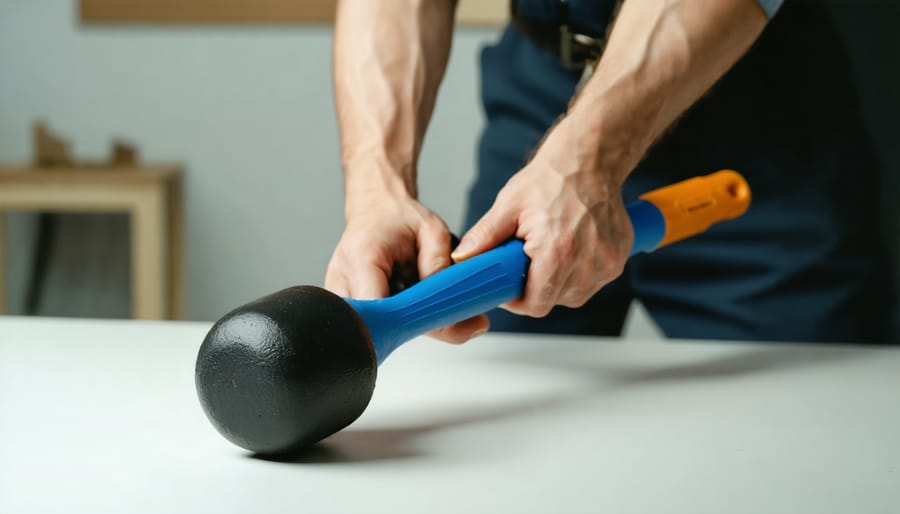
Why Proper Safety Gear Matters During Installation
Solar panel installation involves more than just technical expertise—it requires physically demanding work with specialized tools. When you see installers using heavy rubber mallets to secure mounting hardware or adjust panel positioning, they’re performing tasks that demand both precision and force. This combination makes comprehensive safety gear absolutely essential, not just for regulatory compliance, but for protecting your investment.
Think of it this way: an installer who’s properly protected can work with confidence and focus entirely on the quality of your installation. Without appropriate gear—including steel-toed boots, heavy-duty gloves, safety glasses, and proper fall protection—even experienced professionals face unnecessary risks that could compromise their work or lead to costly delays.
Professional solar companies that follow OSHA safety standards demonstrate their commitment to both worker safety and installation quality. These standards aren’t just bureaucratic requirements—they represent decades of industry knowledge about preventing accidents and ensuring consistent, high-quality results.
For homeowners, installer safety protocols directly impact your experience. Protected workers complete installations more efficiently, with fewer incidents that could damage your property or delay your project. When you’re evaluating solar companies, asking about their safety practices isn’t being overly cautious—it’s a smart way to identify installers who take professionalism seriously. After all, a company that invests in protecting their team will certainly prioritize protecting your home and delivering excellent results.
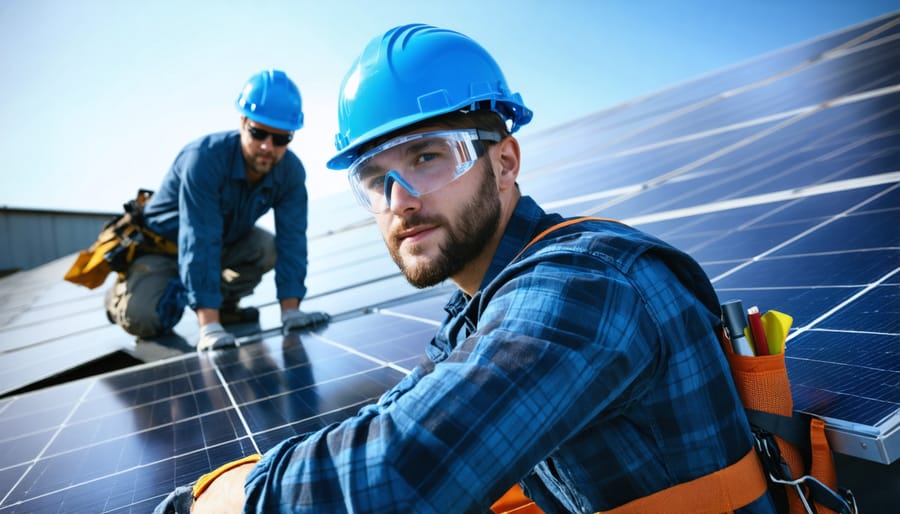
Essential Personal Protective Equipment for Solar Installers
Head and Eye Protection
When solar installers use rubber mallets to secure panels and mounting hardware, they’re working directly beneath heavy equipment and creating small debris with each strike. That’s why professional installers always wear hard hats and safety glasses—two simple but critical pieces of protection.
Hard hats shield installers from falling tools, loose hardware, or accidental bumps against overhead structures. Since most solar installations happen on rooftops where the margin for error is slim, this protection isn’t optional—it’s essential. The good news for homeowners? Installers who prioritize head protection are demonstrating the kind of attention to detail that translates into quality workmanship on your investment.
Safety glasses or goggles protect eyes from flying particles when mallets strike metal components or fasteners. Even seemingly gentle taps can send small metal shavings or dust into the air. Quality installers understand that clear vision throughout the installation process means better precision and fewer mistakes on your roof.
When you see your installation team arrive wearing proper head and eye protection, you’re witnessing professionals who take their craft seriously—and that professionalism directly benefits the long-term performance of your solar energy system.
Hand and Arm Safety
Your hands and arms need serious protection during solar panel installation. When installers swing that heavy rubber mallet to secure mounting brackets and panels, their hands absorb considerable force with each strike. That’s why professional installers wear heavy-duty work gloves with reinforced palms and padded knuckles—these protect against vibration, blisters, and the jarring impact that comes from repetitive hammering.
Beyond the mallet work, installers handle sharp metal components like aluminum rails and steel brackets throughout the day. Quality work gloves prevent cuts from these edges while maintaining the grip strength needed for precision work. Many installers choose gloves with textured rubber coatings that provide excellent grip without sacrificing dexterity.
Long-sleeved shirts or arm guards add another layer of defense against scratches and abrasions, especially when working around rooftop obstacles or maneuvering panels into tight spaces. Professional crews invest in quality PPE equipment because it directly impacts their efficiency and your installation quality. When installers feel protected and comfortable, they work more confidently and carefully—which means your solar system gets installed correctly the first time, protecting your investment for decades to come.
Fall Protection Equipment
When your installer climbs onto your roof with a rubber mallet in hand, they’re relying on critical safety equipment that protects them throughout the workday. Professional solar companies equip their crews with comprehensive fall protection systems, including full-body harnesses, shock-absorbing lanyards, and secure anchor points fastened to your roof’s structure.
These safety measures matter to you as a homeowner because they directly impact installation quality. An installer who’s properly secured can focus completely on precise panel placement and careful mallet work, rather than worrying about their footing. This translates to better attention to detail and a superior finished product on your roof.
The harness system allows installers to move freely while using both hands—essential when positioning panels and tapping them into place with a mallet. Modern fall protection equipment is designed for rooftop work, with anchor points that distribute weight safely without damaging your roof. Professional installers inspect this equipment daily and replace components according to strict safety schedules.
Reputable solar companies invest heavily in this protective gear and ongoing safety training. When you see installers wearing harnesses while working with their tools, you’re witnessing the professional standards that protect both the workers and your home investment.
Footwear and Body Protection
Solar installers spend hours on your roof, often in challenging conditions, which is why proper footwear and body protection are non-negotiable. Steel-toed boots with slip-resistant soles provide essential grip on angled roofs while protecting feet from dropped tools or equipment. These specialized boots also guard against puncture wounds from exposed screws or sharp metal edges during panel mounting.
Beyond footwear, installers wear durable work pants and long-sleeved shirts to protect against sun exposure, weather elements, and abrasions from roofing materials. Many also use knee pads when kneeling to secure mounting hardware, reducing strain during repetitive tasks. Gloves protect hands while maintaining the dexterity needed for precise work with your panels and electrical connections.
This comprehensive protective clothing isn’t just about comfort—it directly impacts your installation quality. When installers are properly protected, they can focus entirely on precision and craftsmanship rather than discomfort or injury risk, ensuring your solar investment is installed correctly the first time.
Electrical Safety Gear
Working with electricity requires specialized protection beyond standard construction gear. Professional installers rely on insulated tools with rubber or plastic handles that prevent electrical current from reaching their hands. These tools are essential when connecting panels to your home’s electrical system.
Before making any connections, installers use voltage testers to confirm circuits are safe to work on—think of it as double-checking that the power is truly off. They also wear rubber-soled boots and insulated gloves rated for electrical work, which provide crucial protection against unexpected shocks.
This electrical safety equipment protects both the installer and your investment. When professionals arrive with proper gear, it’s a good sign they’re following industry safety standards. This attention to detail during installation means fewer risks of electrical issues down the road, giving you peace of mind that your solar system is installed correctly and safely from day one.
What Homeowners Should Look For: Safety Standards That Matter
When choosing a solar installation company, you want to ensure they’re taking safety seriously—it protects both their workers and your investment. Here’s what to look for when evaluating installers.
Start by verifying certifications and credentials. Reputable installers should hold NABCEP (North American Board of Certified Energy Practitioners) certification, which demonstrates they’ve met rigorous training standards. Ask to see proof of proper licensing for your state, as requirements vary by location. These credentials indicate the team understands solar safety standards and installation best practices.
Insurance is non-negotiable. Your installer should carry both general liability insurance and workers’ compensation coverage. This protects you from financial responsibility if accidents occur on your property. Don’t hesitate to request certificates of insurance—professional companies will provide them readily.
During the actual installation, watch for visible safety practices. Crews should arrive with proper personal protective equipment, including hard hats, safety glasses, and non-slip footwear. If they’re working on your roof, fall protection systems like harnesses and guardrails should be standard. The presence of tools like rubber mallets for gentle panel adjustments shows attention to careful installation methods that won’t damage your equipment.
Ask about their safety training programs. Companies that invest in ongoing safety education typically have lower accident rates and higher quality standards. Inquire about their safety record and whether they follow OSHA guidelines.
Finally, trust your instincts. Professional installers will happily answer safety questions and explain their protocols. If a company seems dismissive about safety concerns or can’t provide documentation, consider it a red flag. Your solar installation is a long-term investment—choosing installers who prioritize safety ensures it starts on the right foundation.
How Safety Equipment Protects Your Investment
When your installer arrives wearing proper safety equipment—from hard hats and safety glasses to steel-toed boots and gloves—they’re doing more than following regulations. They’re ensuring your solar system gets installed correctly.
Think about it this way: a worker who feels protected and comfortable can focus entirely on precision. When handling that heavy rubber mallet to secure mounting hardware, steady hands and clear vision matter. Safety glasses prevent debris from compromising their sight lines. Gloves provide the grip needed for controlled, accurate strikes. This attention to detail translates directly into panels that sit perfectly level and connections that remain secure for decades.
Protected workers also move more confidently across your roof, reducing the risk of accidental panel damage or dropped tools that could scratch your new investment. A simple slip without proper footwear could mean a cracked panel or damaged flashing—costly mistakes that proper safety equipment prevents.
Beyond physical protection, professional PPE use signals a company’s commitment to quality. Installers who prioritize their own safety typically bring that same conscientiousness to every aspect of the job, from weatherproofing connections to testing system performance.
Protecting your solar investment starts with the installation itself. When you see installers arrive fully equipped with safety gear, you’re witnessing the foundation of a solar system that will deliver reliable, clean energy for 25 years or more. That peace of mind is priceless.
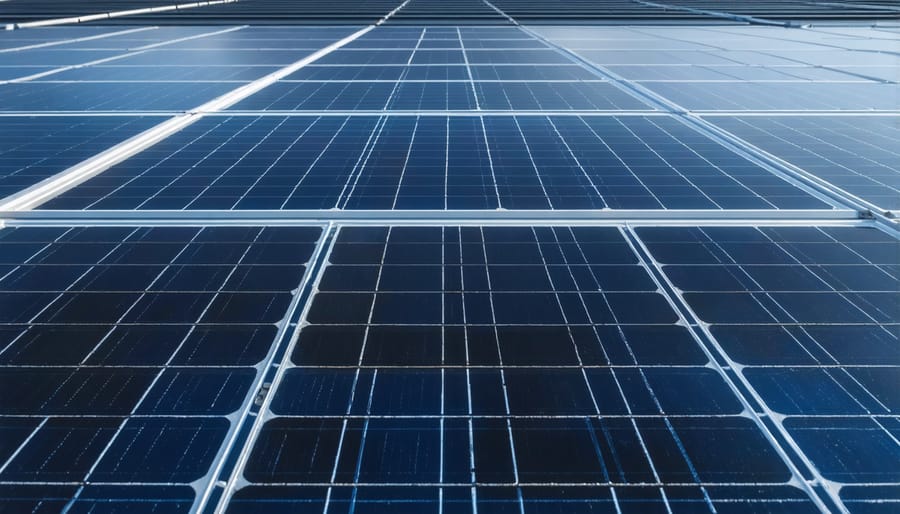
When you see a solar installation crew arrive at your home with rubber mallets, proper safety harnesses, non-slip boots, and other professional-grade equipment, you’re witnessing experts at work. These aren’t just accessories—they’re the hallmarks of a quality installation that protects both the workers on your roof and the solar investment you’re making in your home’s future.
The rubber mallet is just one example of how professional installers use the right tool for each specific task. It protects your panels from damage during assembly while ensuring secure connections that will generate clean energy for decades to come. Combined with comprehensive safety gear, these practices demonstrate a commitment to excellence that translates directly into system performance and longevity.
As you research solar options for your home, prioritize installers who emphasize safety protocols and use appropriate equipment. Ask potential contractors about their safety certifications, insurance coverage, and installation techniques. A professional installer won’t hesitate to explain their process and show you how their attention to detail protects your investment. Your solar journey should begin with confidence, knowing that qualified experts are handling every aspect of your installation with care.

